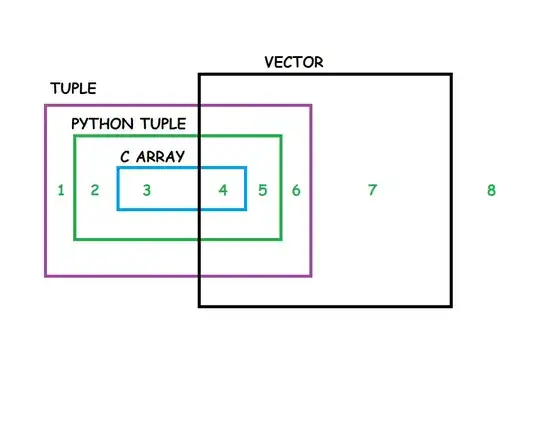DISCUSSION :
Here is my attempt to show the various concepts using Venn Diagram , high-lighting the various entities :

In Math , generally vectors are made of similar numbers ( Integers , rationals , reals , Complex , ETC ) which we can add & multiply. We also have Distance & Norm. There are various ways to Identify Vectors , eg $x,y,z$ Co-ordinates , Polar/Cylindrical/Spherical Co-ordinates , $\hat{i},\hat{j},\hat{k}$ ETC.
In the Venn Diagram VD , that is shown by elements 4,5,6,7.
In Math , tuples may or may not have similar numbers or entities. We can have Integer & Boolean & Set & what-not , all within a Single tuple.
That is shown by elements 1,2,3,4,5,6 in the Venn Diagram VD.
Thus , when tuple has all elements of same type which will satisfy the Criteria for vectors , we have Intersection in the VD : 4,5,6.
In C , the array can have Integers or floats or other numbers. It will then be a vector , which is also a tuple : element 4 in VD.
The array can also have Pointers or Chars or Structs. It will then not be a vector , though it is still a tuple : element 3 in VD.
In Python , the tuple can have Numbers. It will then be a vector , which is also a tuple : elements 4,5 in VD.
The tuple element numbers , which be same in C , need not be Same in Python.
The tuple elements need not be numbers in Python : Element 2 in VD.
In Math there are other Structures & Entities too , like Boolean , Number , Set , Matrix : Element 8 in VD.
Examples & SUMMARY :
1 : Math tuple $(A,B,C,1,2,3\cdots)$ : It has 3 Sets $A,B,C$ & then infinite number of elements. It is not Python tuple & not C Array & not Math vector.
2 : Python tuple $(0,\text{None},\text{""})$ : It is a Math tuple , though not C Array & not Math vector.
3 : C Array having 100 Structs : It is Python tuple & Math tuple , though not Math vector.
4 : C Array having 100 floats : It is Python tuple & Math tuple & Math vector.
5 : Python tuple $(1,2.3,0)$ : It is Python tuple & Math tuple & Math vector.
6 : Vector $(1,2,3,\cdots)$ with infinite elements : It is Math tuple too , though not Python tuple & not C Array.
7 : Vector $3\hat{i}+6\hat{j}+9\hat{k}$ : It is not Python tuple , not C Array & not Math tuple. It could be converted to the Equivalent $(3,6,9)$ which will then be Math tuple.
8 : Logical True , Integer 1 , Set $\{1,2,3\}=\{1,3,2\}=\{3,2,1\}$ , Matrix : These can be neither Math Vector nor Math tuple nor Python tuple not C Array.
Over-view :
Math Vector & Math tuple are very close : Every vector can have Equivalent tuple.
C Array is a type of Python tuple. Python tuple is a type of Math tuple.
There are Structures & Entities other than these.
We might have 8 types of Entities to consider.
ADDENDUM :
I have given very general Examples at very high-level & certain nuances might not be covered.
When the concept of Array & tuple in Programming languages will gradually change , these Examples might have to be modified.
More-over , though there is wide consensus among Mathematicians & Programming Language Designers , it is not universal.
The Vector & Tuple might have slight variations over Country & Domain & time , which will then necessitate slight modifications to the Examples.
